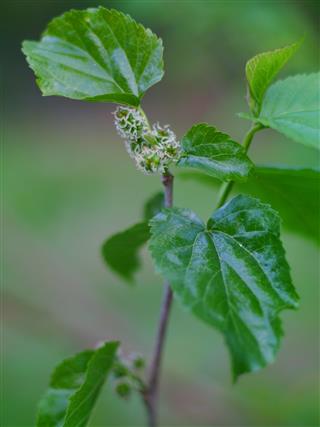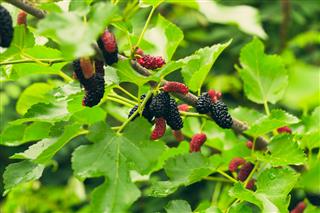
Fruit-bearing trees often require a lot of care and maintenance due to their delicate constitution. But the mulberry tree is a hardy tree species, that requires just the bare necessities of plant care. Let’s take a look at the right growing conditions needed for this tree.
Here we go round the mulberry bush,
The mulberry bush,
The mulberry bush.
Here we go round the mulberry bush
On a cold and frosty morning.
The mulberry tree is one of nature’s most famous small tree species, mainly due to its famous red, purple or black berries and its mention in two popular nursery rhymes. This deciduous tree species, which falls under the scientific plant genus Morus, has at least 10-15 sub-species, which are found in Asia as well as North and South America. Three well-known varieties are white, red and black mulberry trees.
How to Care for a Mulberry Tree
Growing and looking after this fruit-bearing tree is pretty basic and rather simple. The various points of mulberry tree care are elaborated on below.
Soil and Water
Do not plant a mulberry tree’s seeds or saplings near pavements, driveways or paved surfaces. Once the tree bears fruit, such surfaces can be heavily stained with fruit and bird droppings. As it grows, the mulberry tree will grow tall and will soon cast an impressively wide shadow. To prevent overcrowding and accumulation of moisture, plant the tree at least 15 feet away from adjoining trees. It is a hardy species and will grow in moderate to average soil quality but not in gravelly or chalky soils.
For optimum growth, the soil should be deep, loamy, fertile and should drain well. The soil should not remain soggy and wet. In hot climates where the soil can dry quickly, apply a ring of mulch or compost around the tree, to help the soil retain moisture. Mulch replenishes the soil’s nutrients and mineral content as well. The mulberry tree requires fertilizer once in a while, to help enrich the soil’s nutrient levels. Use a balanced fertilizer and apply it once during spring. When applying mulch, make sure it does not touch the base of the tree.
This tree is not very water-dependent and can survive even in drought-like conditions. But a lack of water can affect the quality of fruit borne, and the mulberries will fall prematurely from the tree. In summertime, water the mulberry tree well. Make sure the soil is dry between successive watering. Newly planted trees should be watered well once a week, during their first year of growth.
Light and Temperature
The three types of mulberry trees have different temperature needs. The black mulberry is the most delicate of the entire species and is very vulnerable to cold climates. Being a tropical tree, it has a very low temperature tolerance, so it needs to be planted in a warm climate. USDA Hardiness Zone 7 or warmer are ideal planting zones. The red mulberry is a little more tougher, as it is a native American mulberry species. It can stand temperatures up to -25° C, which comes under USDA Zone 5. This tree will grow well in Zones 6-9. The white mulberry is the toughest of the trio and is the most cold tolerant. Irrespective of their sub-species, mulberry trees require a lot of sunlight. They should be planted in an area that receives direct sunlight for at least 8 hours. Mulberry trees will flourish in shady areas but the quality and quantity of the fruit is poor and even the tree’s structure is weak. Colder the climate, more the sunlight needed.
Pruning
The mulberry tree can grow like a weed in the right conditions, especially the white mulberry sub-species. Pruning the tree will help in improving air circulation and prevent branch overcrowding. It also provides the tree with a strong and sturdy frame. Encourage a tree shape with 2 main branches and manageable number of lateral branches. Too many branches or heavy long branches with a lot of leaves can stress the tree, inhibiting its growth and affecting its overall health. So trim branches back, after the tree is 1-2 years old. Remove dead branches in the winter, to encourage new and healthy branches to grow. The mulberry tree is known to leak sap when cut, so do not make cuts more than 2 inches in diameter, as the tree will bleed sap heavily.
It’s easy to see that the mulberry tree is a little-or-no-fuss, beautiful tree that requires minimal looking after and care. Plus it will bear delicious fruit, that can be eaten raw or enjoyed in various culinary ways and as a dense tree, will provide shade in a sunny garden. Along with taking care of the tree’s needs with respect to water, light etc., one must remember to be patient. It takes 1-2 years for the mulberry to mature and nearly 2-3 years more for the tree to bear fruit. If you wish to enjoy the ornamental beauty of the tree, and are not interested in harvesting the berries, you should plant a fruitless variety or cultivar.

